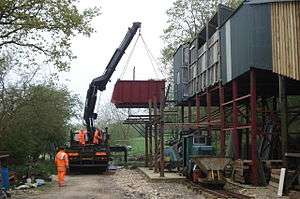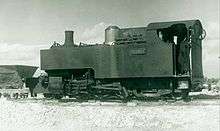Purbeck Mineral and Mining Museum
| Purbeck Mineral and Mining Museum | |
|---|---|
 | |
| Purbeck Mining Museum under construction | |
| Terminus | Norden |
| Commercial operations | |
| Built by | Purbeck Mineral and Mining Museum Group |
| Original gauge | 3ft 9in (1143mm) |
| Preserved operations | |
| Stations | 0 |
| Preserved gauge | 2ft (610mm) |
| Commercial history | |
| Opened | 1854 |
| Closed | 1999 |
| Preservation history | |
| 2004 | Planning permission is granted to develop a museum at Norden Station |
| 2013 | Steam returns to the Line, officially |
| Headquarters | Swanage |
| Website | |
|
www | |
The Purbeck Mineral and Mining Museum is a museum about the history of ball clay mining in the Isle of Purbeck. The museum is based at Norden and is open from the end of March to the end of September on Saturdays,Sundays,Tuesday,Wednesdays and Bank Holidays from 11am to 5pm.
At the site the group has relocated a redundant mine to Norden and built a railway around the site with a new engine shed and the restoration of wagons that worked on the lines around Norden. It is planned to extend the line over the other side of the Swanage Branch line to land owned by the group via Bridge 15. In 2010 a structural engineer surveyed Bridge 15, a skew bridge over the Swanage Railway. The condition of the bridge was good for a "temporary" bridge built in 1885.
History
Middlebere Tramway
The railway was built to remove a "bottleneck" to Staffordshire potteries by building a line from Norden to Middlebere Tramway which was opened in 1806 to a 3 ft 9 in (1,143 mm) gauge for 3.4 miles long. The rails were cast iron, L-shaped 3 ft long and weighing 40 lb, the horse-drawn clay wagons had flangeless wheels, and the sleepers were simply stone blocks (60-70 lb) numbering well in excess of 10,000. (some of the sleepers remain in place today, complete with holes where the rails used to be fixed. Others have been used as paving stones at Langton Wallis Cottage.) The cast iron rails secured to stone blocks (with metal spike and oak dowel) set in the ground.[1] In 1807 the line was extended south under the Wareham to Corfe road. The tunnel exists and is grade listed however it is blocked,[2] a second tunnel was built in 1825 east of the first tunnel but is now blocked and is not grade listed. In 1881 when the LSWR built the Swanage line the line was extended east parallel to the line and Eldons Sidings were built to transfer clay to the standard gauge network. In 1907 Middlebere plateway was abandoned but had been in continual use for 101 years, The quay at Middlebere creek has fallen into disrepair and almost vanished. Some of the stone sleepers remain in place today, complete with holes where the rails used to be fixed, whilst others have been reused as paving stones at various locations. Others can be found in the walls at Middlebere farm. In many places the route across Hartland moor can be traced.
Newton Tramway
In May 1854 a railway opened from the clay pits at Newton to Goathorn Pier on South Deep in Poole Harbour. The Admiralty had given permission for the building of the pier in 1852.The railway was initially horse worked and built at 3 ft (914 mm) foot gauge but was re-gauged to 3 ft 9 in (1,143 mm) to take a Steam locomotive that was built by Stephen Lewin of Poole Foundry in about 1870. The engine was named "Corfe" but was nicknamed "Tiny" because of its size. The nickname became its real name. An engine shed was built at Newton to house "Tiny" and was located alongside clay workers' cottages. The water required for "Tiny" was obtained by hand pump from a well to the south of the engine shed. The coal for "Tiny" would have been brought in by ship via Goathorn Pier. In 1907 the railway was joined to Norden and part of it became the "Fayles Tramway".[3]
Fayles Tramway


In about 1907 the Middlebere tramway fell out of use and a link to Newton was constructed to a gauge of 3 ft 9 in (1,143 mm), rails were laid from a point just southeast of the Slepe Road bridge at Norden across the Heath to join the Newton tramway, giving an outlet to Goathorn Pier. The line was 5 3/4 miles in length, another locomotive was purchased. The railway enabled some of the clay from Norden to be exported via Goathorn pier and in turn some of the clay from Newton to exit Purbeck by train via Eldon Sidings. The railway was also used in 1924 to construct the Training Bank to maintain a navigable approach to Poole Harbour. It was constructed from limestone blocks (Portland and Purbeck stone) which were carried by the railway from Norden to Goathorn where they were loaded on to barges.
The line was constructed using flat-bottomed rail spiked to wooden sleepers with earth ballast in a conventional way. There was an additional locomotive shed at Norden and trackwork included a short branch at Bushey. Other features included a wooden bridge over the Corfe River.
By 1937 the Newton line seems to be little used. The pier at Goathorn ceased to be worked with the Second War requiring the peninsula as part of a bombing range. Much of the line that crossed Newton Heath was taken up in 1940 and there was no working north of the engine shed at NordenThe line was abandoned in 1937 and clay then left by lorry or via the Swanage Branch Line. In 1948 the complex at Norden was regauged to 1 ft 11 1⁄2 in (597 mm). To work the narrow-gauge line one steam-engine and several internal combustion engined rail tractors were purchased. The steam-engine was "Russell" a 2-6-2T Hunslet (1906) with a chequered history. In the final years of the Norden system a number of Ruston & Hornsby 48DL class 0-4-0 engines operated on the line, numbers 392117, 175413 and 179889, also used for a while was a Motorail simplex (c/n 5252).
After the closure of Eldon sidings all clay exports were via lorry. For several years the clay was carried from the mines across the A351 by trains to the "Lorry Drop". It was realised that the lorries could take the clay directly from the mines and the cost of maintaining a railway system avoided. The transhipment buildings were raised to accommodate the lorries beneath them and in the early 1970s the railway system sold partly into preservation and the rest scrapped. Use of narrow gauge railways continued underground at Norden No 6 & 7 mines until all mining operations ceased in 1999.[4]
Future
.jpg)
In 2014 the Purbeck Mineral and Mining Museum set up a plan in conjunction with its governing body the Swanage Railway Trust for a forward plan for the future. The plan involved opening the museum on more days to boost numbers and increase access to areas of the museum previously restricted. Its first priority is to improve interior displays, and to restore the winch and hopper in the mine building to working order which as completed by 2015 and is used for special events.
One of its main priorities is to restore skew arch bridge over the Swanage Railway and to enable access to Norden South, this will allow the Museum with the possibility of expanding the 2 ft gauge railway and operating a passenger service and demonstration clay trains on special event days. The museum also wants to develop a building for Secundus and wagon 28 and moving them from Corfe Castle Station.[5]
Rolling Stock
All 2 ft (610 mm) gauge unless otherwise stated.[6]
Steam locomotives
| Number and name | Wheel arrangement |
Class | Notes | Photograph |
|---|---|---|---|---|
| 'Secundus' | 0-4-0 | Bellis & Seekings Ltd 0-4-0 | 2 ft 8 in (813 mm) gauge, Not operational, at Corfe Castle Station Goods shed. | .jpg) |
| 542 'Cloister' | 0-4-0 | Quarry Hunslet | Operational [7] | <http://srstock.co.uk/getfile.php?mode=view&id=117> |
Diesel locomotives
| Number and name | Wheel arrangement |
Class | Notes | Photograph |
|---|---|---|---|---|
| 283871 'Snapper' | 0-4-0 | 48DL Ruston Hornby Diesel | Operational but requires work to bodywork.[8] | <http://srstock.co.uk/getfile.php?mode=view&id=42> |
| 392117 | 0-4-0 | 48DL Ruston Hornby Diesel | Operational, on loan to museum.[9] |
Carriages
| Number | Type | Notes | Photograph |
|---|---|---|---|
| - | 8 seater passenger carriage | Restored. | <http://srstock.co.uk/getfile.php?mode=view&id=152> |
| - | 12 seater passenger carriage | Restored. | <http://srstock.co.uk/getfile.php?mode=view&id=63> |
Goods wagons
| Number | Type | Notes | Photograph |
|---|---|---|---|
| - | 1 ft 10 in (559 mm) gauge Underground mine tubs | 12 in total, Currently being restored. | <http://srstock.co.uk/getfile.php?mode=view&id=39> |
| 28 | 2 ft 8 in (813 mm) 4-wheeled wagon | Built for the Furzebrook Railway, Awaiting restoration. | |
| - | Goathorn Wagon Flat | Operational. | <http://srstock.co.uk/getfile.php?mode=view&id=43> |
| - | Cement Mixer Wagon | Awaiting Restoration. | <http://srstock.co.uk/getfile.php?mode=view&id=44> |
| 140 | Hudson Skip | Currently being Scrapped.[10] | |
| 16 | Hudson Skip | Awaiting Restoration. | |
| 41 | Allens Skip | Awaiting Restoration. | <http://srstock.co.uk/getfile.php?mode=view&id=46> |
| - | Allens Skip | Under Restoration. | <http://srstock.co.uk/getfile.php?mode=view&id=47> |
| 31 | Flatbed | Awaiting Restoration. | <http://srstock.co.uk/getfile.php?mode=view&id=48> |
| 38 | Flatbed | Restored. | <http://srstock.co.uk/getfile.php?mode=view&id=49> |
| - | Hudson Skip Chassis | Awaiting Restoration. | <http://srstock.co.uk/getfile.php?mode=view&id=50> |
| - | Hudson Skip Chassis | Restored. | <http://srstock.co.uk/getfile.php?mode=view&id=51> |
| - | Small V skip | Awaiting Restoration. | <http://srstock.co.uk/getfile.php?mode=view&id=52> |
| - | Ballast forward tipper | Awaiting Restoration. | <http://srstock.co.uk/getfile.php?mode=view&id=54> |
| - | Drop sided wagon | Restored. | <http://srstock.co.uk/getfile.php?mode=view&id=55> |
| - | Hudson Skip | Under Restoration. | <http://srstock.co.uk/getfile.php?mode=view&id=56> |
| - | Small V skip | Awaiting Restoration. | <http://srstock.co.uk/getfile.php?mode=view&id=58> |
| - | Wide chassis wagon | Awaiting Restoration. | <http://srstock.co.uk/getfile.php?mode=view&id=59> |
| - | Wide chassis wagon | Awaiting Restoration. | <http://srstock.co.uk/getfile.php?mode=view&id=60> |
| - | Wide chassis wagon | Awaiting Restoration. | <http://srstock.co.uk/getfile.php?mode=view&id=61> |
| - | Ex RN Trecwn Explosive Wagon (Converted to PW van) | Restored. | <http://srstock.co.uk/getfile.php?mode=view&id=153> |
| - | Hudson skip | Awaiting Restoration. | <http://srstock.co.uk/getfile.php?mode=view&id=110> |
| - | Lister bogie flatbed | Awaiting Restoration. | <http://srstock.co.uk/getfile.php?mode=view&id=194> |
References
- Fayle's Tramways: Clay Mining in Purbeck by Chris Legg 2014 ISBN 978-0-906294-79-6
- Railways of Dorset J.H.Lucking Railway Correspondence and Travel Society 1968 (No ISBN)
- The Railways of Purbeck R.W. Kidner The Oakwood Press 1973 (reprinted 1979, reprinted & enlarged 1988) ISBN 0-85361-372-9
- The Swanage Branch Then and Now Andrew P.M. Wright Ian Allan 1992 ISBN 0-7110-2046-9 (Amazon)
- Branch Line to Swanage revised edition to 1992 Vic Mitchell and Keith Smith Middleton Press 1992 ISBN 0-906520-33-9
Notes
- ↑ "Fayles Tramway". Webarchive.org.uk. Retrieved 2016-04-21.
- ↑ "MIDDLEBERE TRAMWAY TUNNEL PORTAL - 1390910". Historic England. 2004-04-07. Retrieved 2016-04-21.
- ↑ "Fayles Tramway". Webarchive.org.uk. Retrieved 2016-04-21.
- ↑ "Fayles Tramway". Webarchive.org.uk. Retrieved 2016-04-21.
- ↑
- ↑ "SRStock Public View". Srstock.co.uk. Retrieved 2016-04-21.
- ↑ "Cloister". Festipedia.org.uk. Retrieved 2016-04-21.
- ↑ "Snapper (ex Lynton and Barnstaple". Srstock.co.uk. Retrieved 2016-04-21.
- ↑ "An exciting day at the museum! Our new... - The Purbeck Mineral and Mining Museum". Facebook. 2016-03-17. Retrieved 2016-04-21.
- ↑ "Update from today. The biggest change... - The Purbeck Mineral and Mining Museum". Facebook. 2016-04-17. Retrieved 2016-04-21.
External links
| Wikimedia Commons has media related to Purbeck Mineral and Mining Museum. |
- Swanage Railway website
- Swanage Railway Trust website
- Purbeck Mineral and Mining Museum website
- History of Ball Clay extraction in Purbeck
Coordinates: 50°36′49″N 1°58′56″W / 50.61353°N 1.98235°W